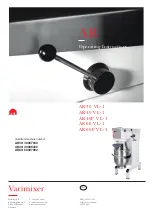
4 – Mixer configuration and settings
3
AUDIO/CLOCK setting status
This shows the status of Dante audio signal and clock.
Item
Content
Sampling rate
This shows the sampling frequency
setting. Tap this area to open a
window where 48kHz or 96kHz can
be selected.
NOTE
If the sampling rate is 48kHz, 64 IN
and 64 OUT will be available. If it is
96kHz, this becomes 32 IN and 32
OUT.
Encoding
This shows the encoding setting.
AES 67 Mode
This shows the AES67 mode.
Latency
This shows the latency setting. Tap
this area to open a window where
the latency (0.25msec, 0.5msec,
1.0msec, 2.0msec or 5.0msec) can
be selected.
Clock Source
This shows the Dante module clock
source (Dante or Sonicview).
Dante Clock Status
This shows the Dante clock status
(Follower or Leader).
Preferred Leader
This shows the Preferred Leader
setting. Tap this area to open a
window where ON or OFF can be
selected.
Notes about Dante
Dante is a transmission protocol developed by Audinate.
Using networks based on gigabit Ethernet standards, it enables
multichannel (512 IN/512 OUT) transmission and high precision,
for example.
Check the Audinate website for details about Dante.
https://www.audinate.com/
Connecting to a Dante network
In order to set up and use this unit, you must also set up the
Ethernet network that it is connected to, a computer that runs
Dante Controller and other devices that support Dante.
Dante controller is not necessary for use, however, when used
with an SB-16D.
LAN cables used for connections
Use STP cables that are category 5e or higher.
Both crossover and straight cables can be used.
ATTENTION
This unit is not compatible with 100Mbps Ethernet switching
hubs. Always use switching hubs that support Gigabit
Ethernet.
NOTE
i
When the Dante Network Addressing setting is AUTO (DHCP),
set the computer to set the IP address automatically.
i
When the Dante Network Addressing setting is STATIC, set
the computer to match the Dante and network address.
Switched (daisy chain) connection
Dante devices can be daisy-chained when there are few
connected devices and when not using a switching hub.
Connect them as shown below.
Switched (daisy chain) connection example
Sonicview 16 /
Sonicview 24
Dante
device
Dante
device
NOTE
i
When using a switched (daisy chain) connection, connect to
either the PRIMARY or SECONDARY connector.
i
If the number of connected devices increases, raising the
latency setting will be necessary.
Redundant connection
For recording situations where retakes are not possible,
including live performances, a connection set up like the
following uses two completely independent primary and
secondary networks.
TASCAM Sonicview 16/Sonicview 24
55
















































